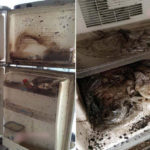Hair loss is a common and normal occurrence for most pets. However, if your dog is experiencing excessive hair loss and itching, it may be more than just a physiological issue. Let’s explore the causes and solutions to this problem together!
1 Is Hair Loss in Dogs Normal?
 Is hair loss in dogs normal?
Is hair loss in dogs normal?
The answer is yes. Hair loss in dogs is a perfectly normal physiological phenomenon. This process is known as the hair replacement cycle. So, if your dog is shedding, it doesn’t necessarily indicate an illness or poor hygiene.
2 Reasons for Hair Loss and Itching in Dogs
Causes of Hair Loss and Itching
While hair loss can be a normal occurrence, excessive shedding accompanied by itching can be indicative of other underlying issues.
 Hair loss caused by parasitic infections
Hair loss caused by parasitic infections
Fleas, ticks, and other parasites can cause hair loss in dogs, often resulting in bald patches. In addition to hair loss, your dog may exhibit symptoms such as inflammation, sores, and intense itching.
Nutritional Deficiency
An inadequate diet can lead to nutritional deficiencies, which in turn can cause hair loss in dogs. Therefore, it’s essential to pay attention to your dog’s diet and make necessary adjustments to ensure they’re getting all the nutrients they need.
Cushing’s Disease
This condition is characterized by an overproduction of cortisol, a stress hormone, in your dog’s body. Symptoms include hair loss, a pot-bellied appearance, muscle atrophy, and weakness. Cushing’s disease typically affects older dogs.
Allergies
Allergies can be triggered by various environmental factors such as pollen, mold, or parasites. When a dog has an allergy, they may experience intense itching, leading to excessive scratching and subsequent hair loss.
3 Treating Hair Loss and Itching in Dogs
 Treating hair loss and itching in dogs
Treating hair loss and itching in dogs
The treatment for hair loss and itching in dogs depends on the underlying cause and the severity of the condition. In some cases, you may need to consult a veterinarian to accurately diagnose the reason for your dog’s hair loss. Here are some possible treatments:
Use Antibiotics and Antifungal Medication for Skin Infections
If your dog is suffering from a parasitic infection, it can lead to hair loss, itching, and even skin infections. In severe cases, it’s crucial to take your dog to the vet, who may prescribe antibiotics or antifungal medications to treat the infection.
Use Tick and Flea Prevention Treatments
If your dog’s hair loss is due to ticks or fleas, you can use specialized sprays or treatments to eliminate these parasites. This will help reduce hair loss and improve your dog’s skin condition.
Use Dog-Safe Shampoos and Conditioners
Inappropriate grooming practices can make your dog more susceptible to parasites and skin infections. Using dog-safe shampoos and conditioners can help maintain your dog’s skin and coat health and prevent hair loss.
4 Preventing Hair Loss and Itching in Dogs
 Ways to prevent hair loss and itching in dogs
Ways to prevent hair loss and itching in dogs
Preventing hair loss and itching in dogs is relatively simple and can be achieved through some easy steps. First and foremost, ensure your dog is receiving a nutritionally balanced diet with all the essential nutrients they need. Proper nutrition will help control and reduce excessive hair loss.
Maintain good hygiene practices for your dog, including regular bathing and grooming. This will help keep bacteria, ticks, and fleas at bay. However, avoid over-bathing your dog, as it can lead to dry skin and increased hair loss.
In addition to bathing, remember to brush your dog’s coat regularly to remove loose hair and stimulate new hair growth.
Additionally, take your dog for regular health check-ups and vaccinations to prevent diseases and effectively manage hair loss.
5 Frequently Asked Questions about Dog Hair Loss and Itching
How Often Do Dogs Shed Their Coat?
Typically, dogs shed their coats twice a year. The first shedding occurs at the end of winter as the temperature starts to rise, and dogs shed their thicker winter coats. The second shedding occurs at the end of autumn as the weather cools down, and they grow a new coat to keep warm.
Should I Bathe My Dog More Often During Shedding Season?
It’s not advisable to bathe your dog too frequently during shedding season. Instead, focus on regular brushing to remove loose hair and keep their coat cool and tangle-free.
 Frequently asked questions about dog hair loss and itching
Frequently asked questions about dog hair loss and itching
What Should I Do If My Dog Is Shedding Due to Physiological Reasons?
If your dog is experiencing physiological hair loss, focus on maintaining good hygiene practices, including proper bathing and regular brushing, to minimize hair loss and encourage new hair growth.
What Should I Do If My Dog Is Losing Hair Around Their Eyes?
Hair loss around the eyes is often a sign of skin conditions such as mange, inflammation, or allergies. In this case, your veterinarian may prescribe antibiotics, antifungal medications, medicated shampoos, or other treatments to address the issue.
We hope this article has provided you with valuable insights on how to address hair loss and itching in your beloved canine companion.
Analyzing Distinctions Between Covid-19 and Seasonal Flu Respiratory Illnesses
Have you been feeling under the weather lately? It might be difficult to tell whether it’s Covid-19 or flu symptoms you are experiencing. Fortunately, there are a few identifying factors that can help us differentiate between these illnesses. In this article, we’ll discuss the key differences between Covid-19 and seasonal flu.




































